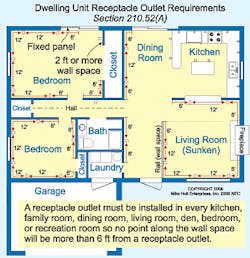All questions and answers are based on the 2008 NEC.
Q. What are the rules on spacing receptacles in a dwelling unit?
A. A receptacle outlet must be installed in every kitchen, family room, dining room, living room, sunroom, parlor, library, den, bedroom, recreation room, and similar room or area so that no point along the wall space is more than 6 feet, measured horizontally along the floor line, from a receptacle outlet [210.52(A)] (Figure).
In addition, a receptacle outlet must be installed for each kitchen and dining area countertop wall space 1 foot or wider, and receptacles must be placed so that no point along the countertop wall space is more than 2 feet, measured horizontally from a receptacle outlet [210.52(C)(1)].
But honestly, there are so many rules on locating receptacles in dwelling units, I suggest you review all of 210.52.
Q. Is PVC conduit permitted to be used to supply circuits in a health care facility?
A. Yes and no. PVC conduit can be used to supply feeder circuits in health care facilities, but not for branch circuits. Branch circuits serving patient care areas must be provided with an effective ground-fault current path by installing the circuits in a metal raceway or cable having a metallic armor or sheath that qualifies as an equipment-grounding conductor in accordance with 250.118 [517.13(A)].
Q. Are switchboards, panelboards, and transformers permitted within a room that serves as a return air space to the air handler?
A. Yes. The requirement that limits wiring methods in return air space doesn't apply to habitable rooms or areas of buildings, the prime purpose of which isn't air handling [300.22(C)].
Q. What are some of the new GFCI protection requirements in the 2008 NEC, and must existing facilities be updated to comply with the new requirements?
A. GFCI protection is required for all 15A and 20A, 125V receptacles located in dwelling unit garages and unfinished basements [210.8(A)(2) and 210.8(A)(5)].
In other than dwelling occupancies, all 15A and 20A, 125V receptacles installed outdoors [210.8(B)(4)] within 6 feet of the outside edge of a sink must be GFCI-protected [210.8(B)(5), and electric drinking fountains must be GFCI protected [422.52].
When receptacles are replaced in locations where GFCI protection is required, the replacement receptacles must be GFCI protected [406.3(D)(2)], but the Code doesn't require you to update your facilities every time a new edition is written.
Q. Is ground-fault protection required for a 1,200A, 277/480V, 3-phase service disconnect switch if it contains a 900A fuse?
A. Yes, ground-fault protection of equipment is required for each service disconnecting means rated 1,000A or more supplied by a 4-wire, 3-phase, 277/480V wye-connected system. The rating of the service disconnecting means is considered to be the rating of the largest fuse that can be installed or the highest continuous current trip setting of a circuit breaker. There are a few points to keep in mind here.
-
Ground-fault protection of equipment isn't permitted for fire pumps [695.6(H)], and it's not required for emergency systems [700.26] or legally required standby systems [701.17].
-
Article 100 defines “Ground-Fault Protection of Equipment” as a system intended to provide protection of equipment from ground faults by opening the overcurrent device at current levels less than those required to protect conductors from damage. This type of protective system isn't intended to protect people, only connected utilization equipment. See 215.10 for similar requirements for feeders.
Q. Are light switches for exterior lighting required immediately adjacent to each entrance of a single-family dwelling?
A. No. The Code specifies the location of the lighting outlet in a dwelling unit [210.70(A)(2)(b)], but it doesn't specify the location of the switch.
Q. When 5 feet of conductor passes through a higher ambient temperature location, must the entire circuit still be subjected to ampacity correction?
A. It depends on the circuit length. When different ampacities apply to a length of conductor, the higher ampacity is permitted for the entire circuit if the reduced ampacity length doesn't exceed 10 feet — and its length doesn't exceed 10% of the length of the higher ampacity [310.15(A)(2) Exception].
About the Author

Mike Holt
Mike Holt is the owner of Mike Holt Enterprises (www.MikeHolt.com), one of the largest electrical publishers in the United States. He earned a master's degree in the Business Administration Program (MBA) from the University of Miami. He earned his reputation as a National Electrical Code (NEC) expert by working his way up through the electrical trade. Formally a construction editor for two different trade publications, Mike started his career as an apprentice electrician and eventually became a master electrician, an electrical inspector, a contractor, and an educator. Mike has taught more than 1,000 classes on 30 different electrical-related subjects — ranging from alarm installations to exam preparation and voltage drop calculations. He continues to produce seminars, videos, books, and online training for the trade as well as contribute monthly Code content to EC&M magazine.
